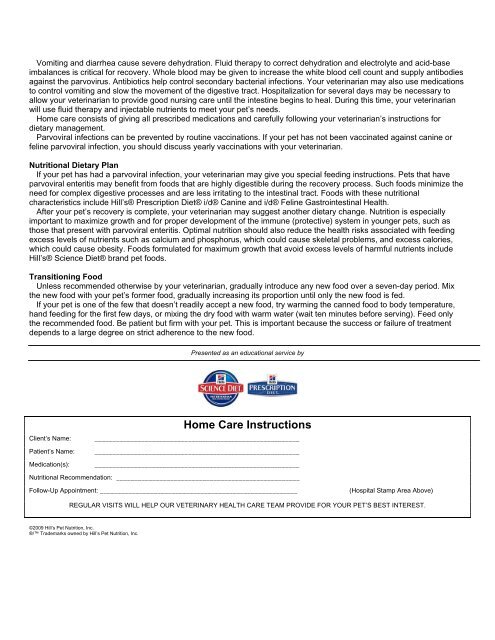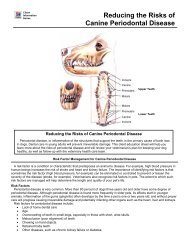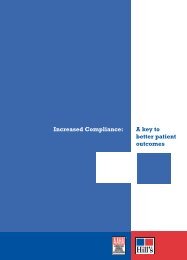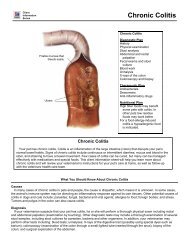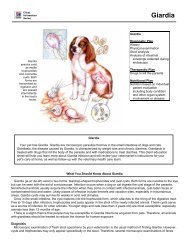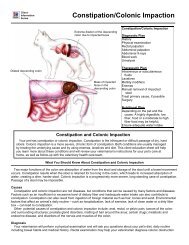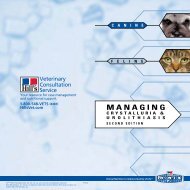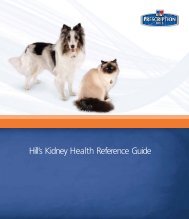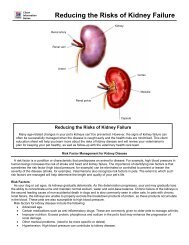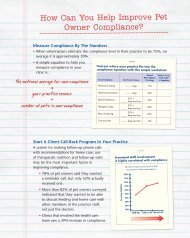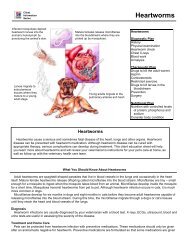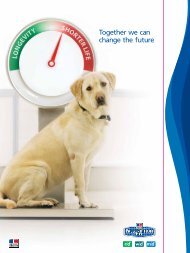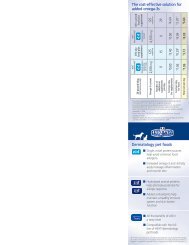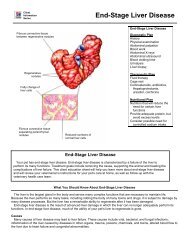Parvoviral Enteritis - HillsVet
Parvoviral Enteritis - HillsVet
Parvoviral Enteritis - HillsVet
You also want an ePaper? Increase the reach of your titles
YUMPU automatically turns print PDFs into web optimized ePapers that Google loves.
Vomiting and diarrhea cause severe dehydration. Fluid therapy to correct dehydration and electrolyte and acid-base<br />
imbalances is critical for recovery. Whole blood may be given to increase the white blood cell count and supply antibodies<br />
against the parvovirus. Antibiotics help control secondary bacterial infections. Your veterinarian may also use medications<br />
to control vomiting and slow the movement of the digestive tract. Hospitalization for several days may be necessary to<br />
allow your veterinarian to provide good nursing care until the intestine begins to heal. During this time, your veterinarian<br />
will use fluid therapy and injectable nutrients to meet your pet’s needs.<br />
Home care consists of giving all prescribed medications and carefully following your veterinarian’s instructions for<br />
dietary management.<br />
<strong>Parvoviral</strong> infections can be prevented by routine vaccinations. If your pet has not been vaccinated against canine or<br />
feline parvoviral infection, you should discuss yearly vaccinations with your veterinarian.<br />
Nutritional Dietary Plan<br />
If your pet has had a parvoviral infection, your veterinarian may give you special feeding instructions. Pets that have<br />
parvoviral enteritis may benefit from foods that are highly digestible during the recovery process. Such foods minimize the<br />
need for complex digestive processes and are less irritating to the intestinal tract. Foods with these nutritional<br />
characteristics include Hill’s® Prescription Diet® i/d® Canine and i/d® Feline Gastrointestinal Health.<br />
After your pet’s recovery is complete, your veterinarian may suggest another dietary change. Nutrition is especially<br />
important to maximize growth and for proper development of the immune (protective) system in younger pets, such as<br />
those that present with parvoviral enteritis. Optimal nutrition should also reduce the health risks associated with feeding<br />
excess levels of nutrients such as calcium and phosphorus, which could cause skeletal problems, and excess calories,<br />
which could cause obesity. Foods formulated for maximum growth that avoid excess levels of harmful nutrients include<br />
Hill’s® Science Diet® brand pet foods.<br />
Transitioning Food<br />
Unless recommended otherwise by your veterinarian, gradually introduce any new food over a seven-day period. Mix<br />
the new food with your pet’s former food, gradually increasing its proportion until only the new food is fed.<br />
If your pet is one of the few that doesn’t readily accept a new food, try warming the canned food to body temperature,<br />
hand feeding for the first few days, or mixing the dry food with warm water (wait ten minutes before serving). Feed only<br />
the recommended food. Be patient but firm with your pet. This is important because the success or failure of treatment<br />
depends to a large degree on strict adherence to the new food.<br />
Presented as an educational service by<br />
Client’s Name:<br />
Patient’s Name:<br />
Medication(s):<br />
Home Care Instructions<br />
_________________________________________________________<br />
_________________________________________________________<br />
_________________________________________________________<br />
Nutritional Recommendation: ___________________________________________________<br />
Follow-Up Appointment: _______________________________________________________<br />
(Hospital Stamp Area Above)<br />
REGULAR VISITS WILL HELP OUR VETERINARY HEALTH CARE TEAM PROVIDE FOR YOUR PET’S BEST INTEREST.<br />
©2009 Hill’s Pet Nutrition, Inc.<br />
®/ Trademarks owned by Hill’s Pet Nutrition, Inc.


